- About MAA
- Membership
- MAA Publications
- Periodicals
- Blogs
- MAA Book Series
- MAA Press (an imprint of the AMS)
- MAA Notes
- MAA Reviews
- Mathematical Communication
- Information for Libraries
- Author Resources
- Advertise with MAA
- Meetings
- Competitions
- Programs
- Communities
- MAA Sections
- SIGMAA
- MAA Connect
- Students
- MAA Awards
- Awards Booklets
- Writing Awards
- Teaching Awards
- Service Awards
- Research Awards
- Lecture Awards
- Putnam Competition Individual and Team Winners
- D. E. Shaw Group AMC 8 Awards & Certificates
- Maryam Mirzakhani AMC 10 A Awards & Certificates
- Two Sigma AMC 10 B Awards & Certificates
- Jane Street AMC 12 A Awards & Certificates
- Akamai AMC 12 B Awards & Certificates
- High School Teachers
- News
You are here
Additional Certainties
February 2008
Pick up a blue-backed deck, commenting, "This deck is frozen—blue with the cold—let's see if we can warm it up." Shuffle a few times, and have several selections made by different spectators. They share the results and announce the sum of the chosen card values. Next, that total is used to dictate how a red-backed deck is shuffled. After a brief handling of this second deck, you reveal the identities of all of the selected cards. You could, for instance, rummage through and pull out matching red-backed cards. The secret, in the situations examined below, is the following:
When several numbers are added up, each may be determined with certainty from the sum.
We start with some observations:
-
There are restrictions on which blue-backed cards may be selected: totally free choices are indeed offered, but from a carefully controlled small subset of the deck. The possibilities may be narrowed down as required using your favourite technique; the simplest method is just to have a stack of appropriate cards (about half a dozen) at the top of the deck, and keep those there throughout some shuffles. (If suits are ignored, then there are numerous other ways to force a selection from a controlled subset, such as using a Gilbreath Shuffle, as explored in the August 2006 Card Colm.) We explain exactly which cards are considered desirable in due course.
-
It's possible to disguise the fact that you ever learn the sum, which adds to the mystery for your audience. E.g., if the red-backed deck is in a known order, such as new deck order—or Si Stebbins, as briefly mentioned in the October 2007 Card Colm—it can be cut several times as long as you know the top card before setting the deck on the table (simply peek at the bottom card). Turn your back while the initial selections are made from the blue-backed deck—the remainder of which is set aside permanently—and have their total found. Have a volunteer silently count out that many cards from the top of the red-backed deck, reversing their order, and have the resulting two piles set side by side.
You turn back, and riffle shuffle the red-backed cards as often as you wish, with one proviso: the top card of the counted-off (smaller) pile must remain on top. Finally, you can easily determine that card's identity—by cutting it to the bottom and peeking, or dealing out the first few cards, or just rummaging through the deck face up—and since it was the last card counted off by the volunteer, you can now figure out just how many cards were counted off, so that you know the total of the selected card values.
-
You may prefer a more casual approach, dispensing with the second deck entirely, and boldly asking for the total. If more than two cards are selected, you can comment that knowing the total doesn't really help, as the Central Limit Theorem makes the sum of several independently chosen random numbers follow a bell-shaped curve, and you don't have normal distribution tables with you (or maybe bring some, and dramatically look them up!).
In any case, despite the apparent difficulty of decomposing the sum into its summands, that's exactly what you do, in many cases correctly naming the card suits too.
One sure-fired way to be able to identify summands from their total is to have the cards selected from ones whose values are distinct powers of 2, for example, an Ace, 2, 4, and 8 (perhaps adding a young "sweet sixteen" Queen). However, we prefer to focus on an alternative to this well-known and oft-explored approach.
Frozen Deck
We need a wonderful fact gleaned from Burger & Starbird's generally excellent Heart of Mathematics (Key Curriculum Press):
non-consecutive Fibonacci numbers (1, 1, 2, 3, 5, 8, 13, 21, 34, ...).
This so-called Zeckendorf representation was apparently first established in 1939, by Edouard Zeckendorf from Belgium, an amateur mathematician—but a real doctor. By the time he published it, in 1972, the word had got out: Cornelis Gerrit Lekkerkerker beat him to print by 20 years.
For instance, 6 = 5 + 1 (we don't allow 3 + 2 + 1 or 3 + 3), and 20 = 13 + 5 + 2. Given any natural number, it's easy to find the appropriate decomposition, by first peeling off the largest possible Fibonacci number, and repeating for the difference, until we are done. For instance, 50 = 34 + 16 = 34 + 13 + 3. (Burger & Starbird discuss a strategic application of this greedy algorithm to the game of Nim.)
Now, consider any Ace, 2, 3, 5, 8 and King (value 13), for instance,
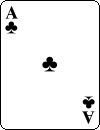

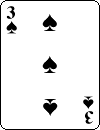

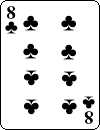
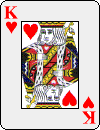
For ease of memorization---you'll need to think fast further down the road---the usual suit rotation CHaSeD is used here. There are 26 - 1 = 63 non-empty sums that can be formed using some (or all) of these six values. We are content to stick with sums of two or three such cards.
Frozen Deck—Take 2
First, let's look at the the (6 x 5)/2 = 15 possible sums of two values. In view of the Zeckendorf result, most of these are distinct, except possibly 1 + 2 = 3, 2 + 3 = 5, 3 + 5 = 8, 5 + 8 = 13, and 8 + 13 = 21. But since those sums are themselves Fibonacci numbers, and as such elements of an increasing sequence, none of these can be expressed in another way as a sum of two Fibonacci numbers. Hence, all 15 sums of two values are distinct; they turn out to be the numbers: 3–11, 13–16, 18 and 21. Thus,
the cards selected can be determined from the sum of their values.
In other words, any possible total can only arise in one way. Even better, it's easy to decompose a given sum into its constituent summands.
Frozen Deck—Take 3
Now, let's look at the (6 x 5 x 4)/(3 x 2) = 20 possible sums of three values. The Zeckendorf result does not seem so helpful here, as it's hard to avoid consecutive Fibonacci numbers. But luck is basically on our side: it's not hard to check that the sums of three values are these 19 distinct totals: 6, 8–24 and 26. Only one sum is repeated, namely 16 = 1 + 2 + 13 = 3 + 5 + 8. Hence,
the cards selected can be determined from the sum of their values
except in the case of the Ace, 2 and 13 (or the 3, 5 and 8).
So with a single exception, any possible total can only arise in one way. This time, of course, it requires more mental agility to decompose a given sum into its constituent summands on the fly. (The point is that we want three summands, so that 14 = 8 + 5 + 1 is preferred to the Zeckendorf decomposition 14 = 13 + 1.) If a sum of 16 occurs---which will happen 10% of the time---you need further information, so fish a little, perhaps saying: "Does somebody have an Ace?" Or, if the cards depicted above are used, mutter half-aloud that you wonder if anyone had a Heart. If two of the three spectators exchange glances, then even before anyone answers, say, "I knew it!" and go on to name the 2♥, K♥, and A♣. If you get blank looks, say, "But you each have one of the other suits, in fact the Three of Spades, Five of Diamonds and Eight of Clubs."
Additional Comments
Having four cards selected and identified is also possible, as the sum of those need only be subtracted from the grand total of 1 + 2 + 3 + 5 + 8 + 13 = 32 to figure out which two cards were not selected. That may be even more impressive for an audience that never suspects you know what six cards are being used. However, having five card selected seems like cheating!
A "mature Joker" (value 21) may be utilized as well as the six cards discussed above to give, er, additional possibilities. Of course, you'll also need a way to distinguish between the left- and right-hand sides of sums such as 1 + 2 + 13 = 3 + 5 + 8, 1 + 2 + 21 = 3 + 8 + 13, and 2 + 3 + 21 = 5 + 8 + 13.
I Exploited Mandalas
All Gibonacci (generalized Fibonacci) sequences, such as the Lucas sequence 2, 1, 3, 4, 7, 11, 18, ..., also have the desired increasing property, at least from the second term on. Since we are constrained by possible card values, let's look at an Ace, 3, 4, 7 and Jack arranged in a circle, such as:
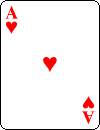


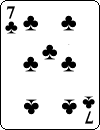
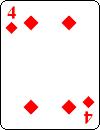
In practice, these would be displayed face down. Again, the values cycle in CHaSeD order—this time starting with the second suit—purely to assist with recall later. If any two cards are picked, and there are (5 x 4)/2 = 10 such pairs this time, then we get distinct sums, for the same reason encountered earlier. Specifically, we get: 4, 5, 7, 8, 10, 11, 12, 14, 15 and 18. Of course, it follows that if any three are picked, we will also get 10 distinct sums, since all five values sum to 26 and the two not picked have distinct sums.
Now, arrange to have on offer two piles (or circles or mandalas) of cards, one with the six cards discussed before, the other with the five above, and have either set picked, and a fixed number of cards (two or three) selected from it. Knowing the sum of those cards—and how many there are and which set they come from—you can work out the identity of the selected cards.
(You can even start with a row of eleven cards, consisting of the two desired sets intertwined, and force their clean separation using a method similar to that discussed in "Martin Gardner's Coins to Cards Effect" in the June 2006 Card Colm).
When all is said and done, we don't even need segments of Gibonacci sequences to be able to pull off the above kind of effect. The set 1, 2, 4, 6, 10 works, as does 1, 2, 5, 7, 13. Adding 1 or 2 (or even 3) across the board to the first of these still keeps us within the realm of a deck of cards. Note that adding 2 yields 3, 4, 6, 8, 12, which dovetails nicely with 1, 2, 5, 7, 13. Those last two examples can be used up to four times over, varying the suits, to produce numerous piles (or mandalas) for selection from a single deck, without the risk of running out of Aces!
With the standard Fibonacci numbers, there is another option to consider.
Adorning Untruths
We already mentioned the easiest way of decomposing sums: by only allowing powers of 2 as summands. Turning things around, we have the binary representation principle behind an old chestnut which appears as "Findley's Four Card Trick" on pages 6-7 of Martin Gardner's Mathematics, Magic and Mystery (Dover, 1956), as prolific magic inventor Max Maven recently reminded us. There, one arranges to have an Ace, 2, 4 and 8 on the top of a deck of cards in one's pocket, and asks that any card in the deck be named. What happens next may be inferred from the variation below. (Incidentally, that trick also works using two Aces, two 3s and a 9, i.e., ternary representations.)
Have a known Ace, 2, 3, 5, 8 and King—in that order, and making sure that all four suits are represented—on top of a deck. Shuffle, maintaining that stack in place, and put the deck in your pocket. Ask somebody to just think of a card, and then name it aloud.
If an Ace, 2, 3, 5, 8 or King is named—which happens with probability 6/13 in an ideal world—all is well. If the suit also matches one of the cards in your stack, then you have a true miracle at your fingertips: fish out that card without hesitation, claiming "I knew you were going to say that." Otherwise, pull out a card that matches the suit first, insisting that you knew that suit would be named, and then a second card that matches the value, with a similarly brazen lie. If a value other than Ace, 2, 3, 5, 8 or King is named, first you match the suit and then pull out—what else?—additional cards whose combined values (with or without the suit match card) equal the value of the named card. More verbal creativity may be required in such cases.
The real root of all of the above may well be the Golden Ratio, surely the most pleasing aspect ratio for playing cards? Or maybe that's just irrational, as Keith Devlin recently argued. Analysed? Omit? Roger!
This Colm has more Fibs in it than most. "Frozen deck," "I exploited mandalas" and "adorning untruths" are anagrams of "Zeckendorf," "additional examples" and "turn things around," respectively. Our overall title this month also has some interesting anagrams which we leave for the curious reader to investigate. For more on mathematical card tricks, including a guide to topics explored in previous Card Colms, see http://www5.spelman.edu/~colm/cards.html.




